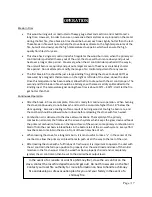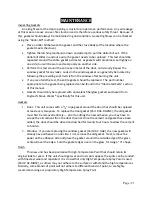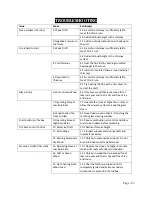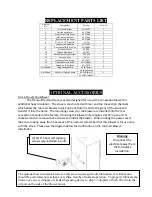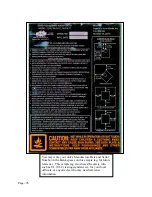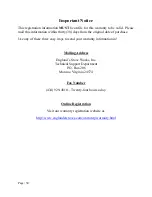
Page | 19
OPERATION
Additional
Safety
Guidelines
The
installation
of
smoke
detectors
is
highly
recommended
when
installing
this
or
any
other
solid
fuel
burning
appliance.
Smoke
detectors
should
be
located
near
or
in
every
room
of
the
home,
particularly
sleeping
rooms.
A
smoke
detector
can
be
installed
in
the
same
room
as
this
cordwood
burning
unit;
installing
the
smoke
detector
too
close
to
the
unit
can
lead
to
nuisance
alarms
due
to
slight
wisps
of
smoke
emitted
during
the
fire
starting
or
reloading
process.
Due
to
this,
the
smoke
detector
in
the
same
room
as
the
unit
will
be
most
useful
if
it
is
located
as
far
from
the
unit
as
the
room
will
permit.
This
stove
is
meant
for
burning
cordwood
only;
never
burn
pressure
treated
wood,
kiln
dried
wood,
creosote
treated
wood
(railroad
ties),
ice
covered
or
wet
wood,
green
wood,
drift
wood,
charcoal,
coal,
coke
or
ANY
other
fuel.
Burning
fuels
other
than
cordwood,
particularly
coal
and
charcoal,
can
result
in
hazardous
concentrations
of
carbon
monoxide
being
emitted
into
the
dwelling.
Installing
a
carbon
monoxide
detector
and
being
aware
of
the
symptoms
of
carbon
monoxide
poisoning
can
help
reduce
the
risk
of
carbon
monoxide
related
issues.
For
these
reasons,
NEVER
burn
coal
or
charcoal
in
this
cordwood
stove.
This
unit
was
designed
for
operation
only
with
the
loading
door
closed
and
tightly
latched.
Operating
this
unit
with
the
loading
door
latched
loosely
or
open
will
allow
excessive
combustion
air
to
reach
the
fire
and
will
result
in
dangerously
high
unit
temperatures.
High
unit
temperatures
can
damage
the
unit,
void
the
warranty
or
ignite
creosote
deposited
in
the
chimney
system
by
previous,
slow
burning
fires.
The
natural
draft
that
pulls
air
through
this
unit
and
allows
the
fire
to
burn
uses
the
indoor
air
of
the
dwelling
for
combustion,
unless
the
unit
is
connected
to
an
outside
combustion
air
source.
Kitchen
range
vent
hoods,
furnaces
and
other
air
movement
appliances
in
the
home
are
often
also
removing
air
from
the
dwelling;
if
the
amount
of
air
filtration
or
leakage
back
into
the
home
is
exceeded
by
the
air
being
removed,
negative
pressure
may
be
created
in
the
home.
Since
this
is
a
natural
draft
appliance,
it
will
often
be
the
first
appliance
to
have
problems
related
to
negative
pressure.
If
smoke
is
forced
out
the
chimney
connector
joints
or
out
of
the
air
induction
system
of
the
unit,
the
unit
is
likely
fighting
negative
pressure
in
the
dwelling.
Cracking
a
window
or
door
near
the
appliance
can
help
equalize
the
negative
pressure;
ultimately,
an
unrestricted
source
of
outside
combustion
may
be
necessary
for
proper
unit
function.
If
the
unit
is
connected
to
outside
air,
be
certain
to
monitor
the
exterior
inlet
to
the
combustion
system
for
icing
or
snow
accumulation.
Allowing
the
outside
air
connection
to
become
restricted
will
result
in
air
starvation
to
the
unit.
DO
NOT
STORE
FUEL
CLOSER
THAN
SPECIFIED
CLEARANCES
TO
COMBUSTIBLES
OR
WITHIN
THE
SPACE
NEEDED
FOR
LOADING
THE
STOVE
AND
FOR
ASH
REMOVAL.













